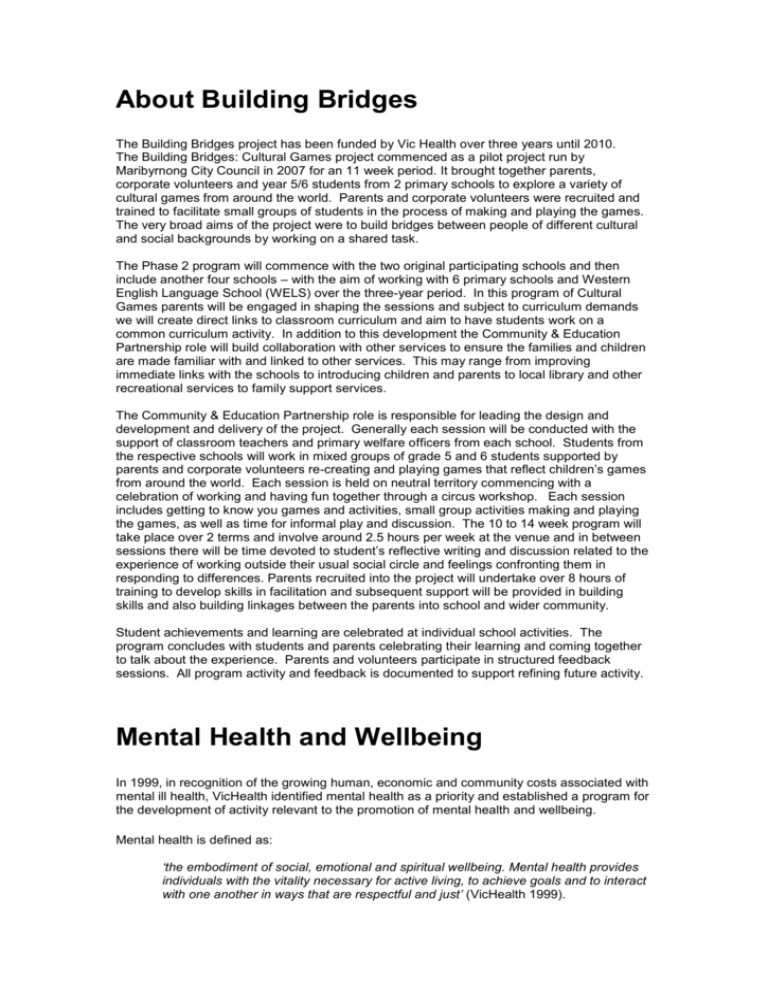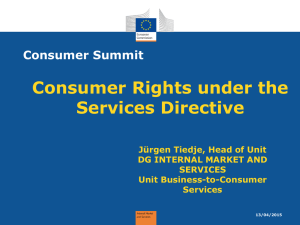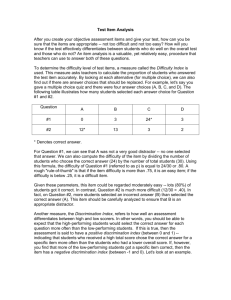About Building Bridges - Maribyrnong City Council
advertisement

About Building Bridges The Building Bridges project has been funded by Vic Health over three years until 2010. The Building Bridges: Cultural Games project commenced as a pilot project run by Maribyrnong City Council in 2007 for an 11 week period. It brought together parents, corporate volunteers and year 5/6 students from 2 primary schools to explore a variety of cultural games from around the world. Parents and corporate volunteers were recruited and trained to facilitate small groups of students in the process of making and playing the games. The very broad aims of the project were to build bridges between people of different cultural and social backgrounds by working on a shared task. The Phase 2 program will commence with the two original participating schools and then include another four schools – with the aim of working with 6 primary schools and Western English Language School (WELS) over the three-year period. In this program of Cultural Games parents will be engaged in shaping the sessions and subject to curriculum demands we will create direct links to classroom curriculum and aim to have students work on a common curriculum activity. In addition to this development the Community & Education Partnership role will build collaboration with other services to ensure the families and children are made familiar with and linked to other services. This may range from improving immediate links with the schools to introducing children and parents to local library and other recreational services to family support services. The Community & Education Partnership role is responsible for leading the design and development and delivery of the project. Generally each session will be conducted with the support of classroom teachers and primary welfare officers from each school. Students from the respective schools will work in mixed groups of grade 5 and 6 students supported by parents and corporate volunteers re-creating and playing games that reflect children’s games from around the world. Each session is held on neutral territory commencing with a celebration of working and having fun together through a circus workshop. Each session includes getting to know you games and activities, small group activities making and playing the games, as well as time for informal play and discussion. The 10 to 14 week program will take place over 2 terms and involve around 2.5 hours per week at the venue and in between sessions there will be time devoted to student’s reflective writing and discussion related to the experience of working outside their usual social circle and feelings confronting them in responding to differences. Parents recruited into the project will undertake over 8 hours of training to develop skills in facilitation and subsequent support will be provided in building skills and also building linkages between the parents into school and wider community. Student achievements and learning are celebrated at individual school activities. The program concludes with students and parents celebrating their learning and coming together to talk about the experience. Parents and volunteers participate in structured feedback sessions. All program activity and feedback is documented to support refining future activity. Mental Health and Wellbeing In 1999, in recognition of the growing human, economic and community costs associated with mental ill health, VicHealth identified mental health as a priority and established a program for the development of activity relevant to the promotion of mental health and wellbeing. Mental health is defined as: ‘the embodiment of social, emotional and spiritual wellbeing. Mental health provides individuals with the vitality necessary for active living, to achieve goals and to interact with one another in ways that are respectful and just’ (VicHealth 1999). VicHealth supports a range of activities relevant to mental health promotion including: Research, monitoring and evaluation Direct participation programs Organisational development (including workforce development) Community strengthening Communication and social marketing Advocacy Legislative and policy reform. Promoting mental health and wellbeing Our activity is directed towards strengthening three key areas for promoting mental health and wellbeing: Social inclusion (having supportive relationships, opportunity for involvement in community and group activity and civic engagement). Valuing diversity and working against discrimination and violence (having physical security and opportunity for self determination and control of one’s life). Access to economic resources (access to work, education, housing, money). Building Bridges funding has a focus on the areas of discrimination and social exclusion affecting migrant and refugee communities. Background to the Funding Discrimination occurs when people are treated differently, usually unfairly, because they belong to a particular group. Discrimination can have a serious impact on mental health and wellbeing (Brown et al 2000, Williams-Morris 2000, Paradies 2006). It contributes to depression, anxiety and poor self-esteem (ibid). Although Victoria has a proud record of welcoming people from migrant and refugee backgrounds, unfortunately discrimination still affects these groups (Human Rights and Equal Opportunity Commission 1999, Poynting and Noble 2004, Dunn et al 2004). A range of strategies are needed to address discrimination affecting people from migrant and refugee backgrounds (Pederson et al. 2005). Building Bridges is one of these and complements other initiatives being undertaken both by VicHealth and other organisations to address this problem. VicHealth support for the Building Bridges Program is based on studies showing that a very effective way of reducing discrimination is through activities that bring affected groups together with members of the wider community to work cooperatively on a common goal. Through this, meaningful relationships form, leading to a better understanding between groups. This in turn can help to break down the negative attitudes and beliefs that lead to discrimination and exclusion (Pettigrew & Tropp 2006). Whilst there is strong evidence to support the effectiveness of intercultural contact as a mechanism to reduce discrimination many of these studies have been conducted overseas and of these most have occurred in contexts where there are identifiable ‘in’ and ‘out’ groups. Building Bridges, established in 2004, is the first time a program based on this approach has been developed and systematically trialled in multiple settings in Australia. The program has been developed to find out whether similar results can be achieved in addressing discrimination affecting cultural minorities in Australia’s culturally diverse environment. It is anticipated that lessons learned from the program will be used by VicHealth and its partners to improve anti-discrimination efforts in Victoria. In Phase I, which is currently underway, 40 community based projects were funded throughout Victoria for between 12 and 18 months. In Phase II, up to five promising projects will be selected for expansion to be part of an intervention research (evaluation) program and will be followed over a three year period to test whether the approach is an effective way of reducing discrimination. Drawing on learning from Phase I, Phase II selection criteria have been modified to reflect an increased recognition that social distance and tension between members of two or more migrant and refugee communities may also provide a strong rationale for activities promoting contact. Intercultural Contact Initiatives are most likely to be successful in reducing discrimination when they: bring people from groups affected by discrimination, tension or social distance together involve a collaborative (non competitive) activity and a goal that all participants believe to be important provide sustained opportunities for people to get to know one another and build meaningful relationships bring participants together on equal terms have support in their organisation or community and are provided in a safe and welcoming environment in which cultural diversity is valued (Pettigrew 2006). Phase II projects should be specifically designed to meet as many of these conditions as possible References Brown TN, Williams DR, Jackson JS, Neighbors HW, Torres M, Sellers SL & Brown KT 2000, ‘Being black and feeling blue: the mental health consequences of racial discrimination’, Race and Society, 2:117–31. Dunn K. Forrest J. Burnley I. and MacDonald A. 2004, Constructing racism in Australia. Australian Journal of Social Issues,39(4),409-430. HREOC 1999, New Countries, New Stories. Discrimination and Disadvantage Experienced by People in Small and Emerging Communities, Human Rights and Equal Opportunity Commission, Canberra. Kessler RC, Mickelson KD & Williams DR 1999, ‘The prevalence, distribution, and mental health correlates of perceived discrimination in the United States’, Journal of Health and Social Behaviour, 40:208–30. Paradies Y, A systematic review of empirical research on self-reported racism and health International Journal of Epidemiology 2006 Aug;35(4):888-901 http://ije.oxfordjournals.org/cgi/content/abstract/dyl056v1 Pederson A. Walker I. Wise M, “Talk does not cook rice”: beyond anti-racism rhetoric to strategies for social action. Australian Psychologist, March 2005; 40 (1): 20-30 Pettigrew T F & Tropp L R 2006, A Meta-Analytic Test of Intergroup Contact Theory Journal of Personality and Social Psychology Vol 90 No 5, 751-783. Poynting S and Noble G 2004, Living with Racism: the Experience and reporting by Arab and Muslim Australians of discrimination, abuse and violence since 11 September 2001: Report to the Human Rights and Equal Opportunity Commission Centre for Cultural Research University of Western Sydney. Williams DR & Williams-Morris R 2000, ‘Racism and mental health: the African American experience’, Ethnicity and Health; 5:243–68 Objectives The objectives of the Building Bridges Scheme: PHASE II are as follows: To engage people from migrant and refugee backgrounds affected by discrimination and social exclusion with those from the wider community, and/or bring together members of two or more migrant and refugee communities where social distance and tension are apparent, to work together on equal terms towards a common goal. To provide sustained opportunities for people from different cultural backgrounds to build relationships with one another and develop mutual understanding. To provide sustained opportunities for participants to explore and recognise their differences while also appreciating their common humanity. To increase the capacity of the wider community and migrant and refugee groups to work collaboratively to plan and implement community activities. To foster new partnerships and strengthen existing partnerships between community based groups and organisations. To support organisations and communities to build capacity to address discrimination and promote social inclusion. To raise community awareness of the role of discrimination in poor mental health and the mental health benefits of social inclusion and valuing of diversity for all. To increase understanding of strategies and approaches to address discrimination affecting people from migrant and refugee backgrounds. To explore the evidence base for intercultural contact as a mechanism to reduce discrimination affecting people from migrant and refugee backgrounds.







